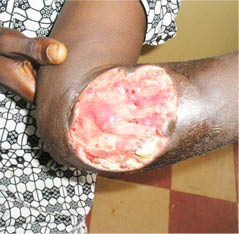What to know about Buruli ulcer
Umeh recalls that his younger brother (Ikenna)’s ailment started with a painless swelling on his left foot which developed into a massive ulcer after some time. He said everyone in his village said his brother had ‘stepped on poison’, and his parents took him to a herbalist. Flood: NOA asks Jigawa residents to clear drains […]

Umeh recalls that his younger brother (Ikenna)’s ailment started with a painless swelling on his left foot which developed into a massive ulcer after some time.
He said everyone in his village said his brother had ‘stepped on poison’, and his parents took him to a herbalist.
- Flood: NOA asks Jigawa residents to clear drains
- 670 cases, 4 deaths recorded as monkeypox hits Lagos, FCT, 22 others
However, months of treatment did not yield any result as the wound grew larger, his brother found it difficult to walk properly and flies always accompanied the ulcerative lesions on his feet.
Succour came Ikenna’s way when an organisation came on a medical outreach in his community. The health workers assisted him to seek care at a hospital in a neighbouring state.
Umeh said Ikenna was diagnosed of Buruli ulcer and began treatment to the shock of many who thought it was a spiritual problem and not a problem to be handled by modern medicine, as widely believed in his part of the country.
Though his brother is better now and working in one of the South East states, Umeh laments that there is still high level of ignorance about the disease, especially in endemic states.
“The health workers actually had a hard time convincing my parents and other people around that the ‘wound’ was a disease, because there were other people who had suffered from the same symptoms in the village and surrounding areas; and they have always been tagged as people suffering from poison or ‘marching charm.’
“Many of them both young and old died with the disease,” he narrated.
Buruli ulcer, is a devastating skin disease which leads to extensive destruction of skin and soft tissue with the formation of large ulcers usually on the legs or arms.
Some of the states that have recorded cases from 2016 to date include Cross River, Ebonyi, Bayelsa, Ogun, Anambra, Osun, Delta, Rivers, Abia, Borno, Edo, Ondo, Federal Capital Territory (FCT), Imo, Gombe, Ondo, Enugu, Lagos, Ekiti, Kebbi, Benue, Kaduna, Oyo, Plateau and Nasarawa.
In 2019, almost 700 cases were recorded across the country with Bayelsa State alone recording 132 cases.
According to Adebayo Peters, a Deputy Director at the National Tuberculosis, Leprosy and Buruli Ulcer Control Programme of the Federal Ministry of Health, the disease is caused by mycobacterium ulcerans, an environmental mycobacterium that occupies a specific place within aquatic environments such as small aquatic animals, biofilms from where it is transmitted to humans by an unknown mechanism.
He said it is one of the most neglected but treatable tropical diseases, adding that the causative organism is from the family of bacteria which causes tuberculosis and leprosy but has received less attention than those diseases.
“The disease can affect any part of the body; about 90 per cent of the cases are on the limbs, with nearly 60 per cent of all lesions on the lower limbs. All ages and sexes are affected, but most patients are among children under 15 years of age.
“Buruli ulcer occurs most frequently among people who live or work close to rivers and slow-moving bodies of water.
“Activities that take place near water bodies, such as farming, are risk factors, and wearing protective clothing appears to reduce the risk of the disease,” he said.
He said the incubation period is 1 – 9 months and patients who are not treated early often suffer long-term functional disabilities such as restriction of joint movement.
While saying that there is also no evidence that the disease can be transmitted from person to person, he said early diagnosis and treatment are vital in preventing such disabilities.
The symptoms of the disease include:
– Painless nodule at onset
– Large area of indurations or diffuse swelling of the legs or arms
– The disease may progress without fever or pain
– Without treatment, massive ulcer with classical undermined borders, sometimes bone is affected causing gross deformities
– When lesions heal, scarring may cause restricted movement of limbs and other permanent disabilities.
He said Buruli ulcer disease often leaves victims with harrowing scars and severe contractures, resulting in social stigma and functional limitations such as :
-Eye complications
-Contractures
-Amputations
Adebayo Peters said Buruli ulcer develops in stages, namely nodule, plaque, oedema, ulcer and osteomyelitis.
He explained that the nodule stage is usually a painless, palpable, firm lesion 1-2 cm in diameter, situated in the subcutaneous tissue and typically attached to the skin, while the plaque stage is usually a painless, well-demarcated, elevated, indurated lesion, more than 2cm in diameter.
He said the oedema stage is a diffuse, extensive, usually non-pitting swelling.
“The affected area has ill-defined margins, is firm and painless and involves part or all of a limb or other part of the body. There may be colour changes over the affected area and the disease may be accompanied by fever,” he stated.
The expert added that the ulcerative stage is defined as a skin ulcer characterised by necrotic slough and undermined edges. In the absence of secondary bacterial infection, the ulcer is usually painless.
Peters said the World Health Organisation (WHO) recommends that all patients with Buruli ulcer lesions should be treated with daily Rifampicin 10mg/ Body kg + Clarithromycin 15mg/Body kg for eight weeks (56 days).
He said surgery is reserved as adjuvant therapy and it is also treated through wound care.
